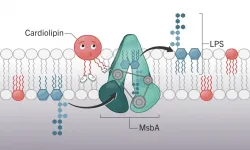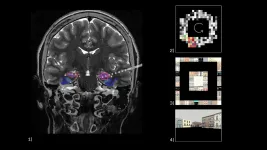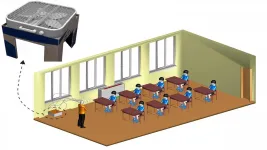Ultrasensitive antigen test detects SARS-CoV-2 and influenza viruses
Novel chip-based diagnostic technology can detect individual viral antigens in nasal swab samples to identify the viruses that cause COVID-19 and flu with a single test
2021-05-11
(Press-News.org) Researchers at UC Santa Cruz have developed a novel chip-based antigen test that can provide ultrasensitive detection of SARS-CoV-2 and influenza A, the viruses that cause COVID-19 and flu, respectively.
The test is sensitive enough to detect and identify individual viral antigens one by one in nasal swab samples. This ultrasensitive technique could eventually be developed as a molecular diagnostic tool for point-of-care use. The researchers reported their findings in a paper published May 4 in Proceedings of the National Academy of Sciences.
"This is a chip-based biosensor capable of detecting individual proteins one at a time, and we show how it can be used to detect and identify the antigens for multiple diseases at the same time," said senior author Holger Schmidt, professor of electrical and computer engineering at UC Santa Cruz.
"It's a whole new way of looking for molecular biomarkers, not only for infectious diseases, but for any protein biomarkers used in medical testing," added Schmidt, who holds the Kapany Chair in Optoelectronics and directs the W. M. Keck Center for Nanoscale Optofluidics at UCSC's Baskin School of Engineering.
The current gold standard for diagnosing SARS-CoV-2 infections uses PCR technology to amplify small amounts of the virus's genomic material, and samples are analyzed in centralized laboratories such as UCSC's Colligan Clinical Diagnostic Laboratory. Antigen tests, which detect viral proteins, are faster and easier to use and have been approved for testing at the point of care (e.g., doctor's offices) and even for at-home use, but these tests are not considered accurate enough for clinical decision-making, and their results may require confirmation with a more reliable technique.
The new chip-based antigen test is not only highly sensitive, but also enables simultaneous testing for multiple viruses from one sample. This is important for diseases such as COVID-19 and flu which have similar symptoms. Measures implemented to control the COVID-19 pandemic have reduced the incidence of flu dramatically, but in the future doctors may need a rapid test that can tell them which respiratory virus a patient is infected with.
Schmidt's lab, in collaboration with coauthor Aaron Hawkins' group at Brigham Young University, has pioneered "optofluidic chip" technology for biomedical diagnostics, combining microfluidics (tiny channels for handling liquid samples on a chip) with integrated optics for optical analysis of single molecules.
To develop the new antigen test, Schmidt's team designed a fluorescent probe bright enough that individual markers can be detected optically on the chip. "The ability to detect individual markers means there is no need for an amplification step, which removes some of the complexity of the processing," he explained.
Schmidt's lab had been developing tests for other infectious diseases when COVID-19 emerged as a global pandemic last year. At first, research ground to a halt as a statewide shutdown kept everyone at home. But it was clear to Schmidt that the diagnostic technology his lab was developing for Zika virus and other infectious diseases could be adapted for COVID-19.
"Once we were allowed to come back to the lab for essential research, my students started coming in to work in the lab by themselves on a coronavirus test," Schmidt said. "It was a heroic effort by my students to develop these tests from scratch. First we were shut down by the pandemic, and then the wildfires hit and we had to evacuate our samples to Stanford and shut down again. But they kept going."
Graduate student Alexandra Stambaugh led the effort and is first author of the paper. The team worked with the campus diagnostic lab to obtain nasal swab samples for testing. They only used samples that had tested negative for the coronavirus, adding viral antigens to the samples at clinically relevant concentrations to validate the tests.
The test uses an "antibody sandwich" approach commonly used for immunoassays. In this case, antibodies specific for the target antigen are attached to magnetic microbeads, so that any target antigen present in the sample sticks to the beads. After washing, a second antibody with the fluorescent marker attached is added, and it binds to any target antigen present on the beads. The fluorescent markers are attached to the antibodies by a spacer that can be cleaved by ultraviolet light, which releases the markers to flow through the detection chip where they are detected one by one. The researchers attached a green marker to the coronavirus antibody and a red marker to the influenza antibody to distinguish between the two viruses.
INFORMATION:
In addition to Schmidt and Stambaugh, the coauthors of the paper include Joshua Parks , who initiated the development of the novel fluorescent markers, and Gopikrishnan Meena, both at UC Santa Cruz, as well as Matthew Stott and Aaron Hawkins at Brigham Young University. This work was funded by the National Institutes of Health and the University of California.
ELSE PRESS RELEASES FROM THIS DATE:
2021-05-11
Rheumatic heart disease (RHD) remains a major cause of cardiovascular disease in Africa, even as acute rheumatic fever and RHD have become rare in high-income countries. In a new study led by investigators at Brigham and Women's Hospital, the team modeled the investment case for control of RHD in the African Union (AU) region. Results showed the potential to reduce RHD death by almost a third by increasing coverage of RHD interventions in regions of the AU to 2030, with a high return on investment in both the long and short term. Their results are published in The Lancet Global Health.
"Investing in early detection of rheumatic fever and rheumatic heart disease and providing cardiac surgery to those who need it ...
2021-05-11
Gram-negative bacteria are the bane of health care workers' existence.
They're one of the most dangerous organisms to become infected with--and one of the hardest to treat. But new research from the University of Georgia suggests a component of bacteria's cell walls may hold the key to crushing the antibiotic-resistant microbes.
The reason Gram-negative bacteria are difficult to kill is their double cell membranes, which create an almost impenetrable shield of protection. This shield blocks antibiotics from entering, preventing medications from doing their job of destroying the bacteria. Meanwhile, toxic molecules, known as lipopolysaccharides, on the surface of the bacteria's outer membrane provoke a potentially deadly immune response.
In ...
2021-05-11
ITHACA, N.Y. - A project based in Tanzania found significant improvements in the diversity of children's diets and food security for households after farmers learned about sustainable crop-growing methods, gender equity, nutrition and climate change from peer mentors.
The farmers experimented with practices introduced to them by Malawian farmers and Tanzanian and American scientists, decided which ones to incorporate within their own farms, and met monthly to share experiences and problem-solve.
The three-year study builds on longer-term research where these environmentally-friendly farming methods, called agroecology, combined with peer-mentoring and farmers collaborating in the process, had successfully improved adult nutrition in Malawi.
"There were a lot of questions about whether ...
2021-05-11
May 11, 2021 - For patients seen at a urology clinic, patient satisfaction scores vary by insurance status - with higher scores for patients on Medicare and commercial insurance, but lower scores for those on Medicaid, reports a study in Urology Practice®, an Official Journal of the American Urological Association (AUA). The journal is published in the Lippincott portfolio by Wolters Kluwer.
"Our study adds to previous evidence showing patient satisfaction scores are affected by the type of insurance - not just by the quality of care provided," comments senior author Werner de Riese, MD, PhD, Chair of the Department of Urology of Texas Tech University Health Sciences Center ...
2021-05-11
Columbia Engineering/UCLA team is first to demonstrate that phase precession plays a significant role in the human brain, and links not only sequential positions, as seen in animals, but also abstract progression towards specific goals.
New York, NY--May 11, 2021-- For decades the dominant approach to understanding the brain has been to measure how many times individual neurons activate during particular behaviors. In contrast to this "rate code," a more recent hypothesis proposes that neurons signal information by changing the precise timing when they activate. One such timing code, called phase precession, is commonly observed in rodents as they navigate through spaces and is thought to form the ...
2021-05-11
WASHINGTON, May 11, 2021 -- Improved ventilation can lower the risk of transmission of the COVID-19 virus, but large numbers of decades-old public school classrooms lack adequate ventilation systems. A systematic modeling study of simple air cleaners using a box fan reported in Physics of Fluids, by AIP Publishing, shows these inexpensive units can greatly decrease the amount of airborne virus in these spaces, if used appropriately.
A low-cost air cleaner can be easily constructed from a cardboard frame topped by an air filter and a box fan. The air filter is placed between the fan and the cardboard base. The fan is oriented so that air is drawn in from the top and forced through ...
2021-05-11
PITTSBURGH, May 11, 2021 - Patients with clinically diagnosed neurological symptoms associated with COVID-19 are six times more likely to die in the hospital than those without the neurological complications, according to an interim analysis from the Global Consortium Study of Neurologic Dysfunction in COVID-19 (GCS-NeuroCOVID).
A paper published today in JAMA Network Open presents early results of the global effort to gather information about the incidence, severity and outcomes of neurological manifestations of COVID-19 disease.
"Very early on in the pandemic, it became apparent that a good number of people who were sick enough to be hospitalized also develop neurological problems," said lead author Sherry Chou, ...
2021-05-11
What The Study Did: This global observational study included patients with COVID-19 representing 13 countries and four continents, and its findings suggest neurological manifestations are prevalent among patients hospitalized with COVID-19 and associated with higher in-hospital death.
Authors: Sherry H-Y. Chou, M.D., M.Sc., of the University of Pittsburgh School of Medicine, is the corresponding author.
To access the embargoed study: Visit our For The Media website at this link https://media.jamanetwork.com/
(doi:10.1001/jamanetworkopen.2021.12131)
Editor's Note: The article includes conflict of interest and funding/support disclosures. Please see the article for additional information, ...
2021-05-11
Furthering efforts to understand why potentially life-saving statins are so under-prescribed among American patients with heart disease, a new study shows that clinicians are more likely to sign a script for them earlier in the day. The new study by researchers in Penn Medicine's Nudge Unit found that patients with the very first appointments of the day were most likely to have statins prescribed, and the odds progressively fell through the morning and remained low throughout the afternoon. The study was published today in JAMA Network Open.
In recent years, researchers ...
2021-05-11
WASHINGTON, May 11, 2021 -- When trauma, illness, or injury causes significant muscle loss, reconstructive procedures for bioengineering functional skeletal muscles can fall short, resulting in permanent impairments.
Finding a synergy in the importance of biochemical signals and topographical cues, researchers from Wake Forest Institute for Regenerative Medicine, Sungkyunkwan University, and Chonnam National University developed an efficient technique for muscle regeneration and functional restoration in injured rats. They describe results from the technique in the journal Applied Physics Reviews, from AIP Publishing.
The group expanded on a method they previously developed using muscle-specific materials derived from ...
LAST 30 PRESS RELEASES:
[Press-News.org] Ultrasensitive antigen test detects SARS-CoV-2 and influenza viruses
Novel chip-based diagnostic technology can detect individual viral antigens in nasal swab samples to identify the viruses that cause COVID-19 and flu with a single test





